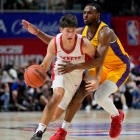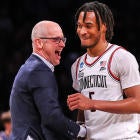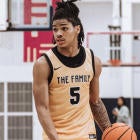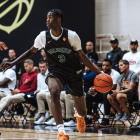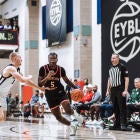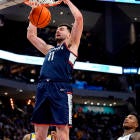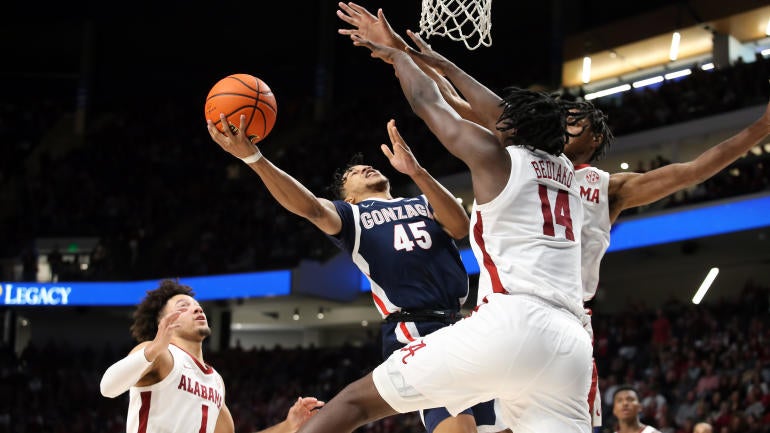
It's really, really hard to determine the "best" in any sport, but especially in college basketball where the pure vastness -- 363 Division-I teams across 32 conferences (and two Independent teams) -- is overwhelming. Is a dominant team in a relatively weak conference "better" than a very good team in a very good conference?
Then there are the other questions. Do you favor pure volume? Efficiency? For example: Penn State has one of the most efficient transition offenses among NCAA Tournament teams on a points-per-possession basis (1.23 PPP). But the Nittany Lions are hardly ever in these scenarios: Their 9.0 transition points per game ranks 298th in Division I. How do we weigh each when determining the tournament's "best" transition team?
In the end, it's an imperfect science. But so is comparing teams when picking a bracket. That's what makes this time of year so much fun -- and so stressful.
Brackets are here! Get back in your pools and join our Men's and Women's Challenges for the chance to win a new SUV and a college basketball dream trip!
Without further ado, here are the superlatives among the 68 teams in this year's NCAA Tournament field.
Offense
Best offense: Gonzaga Bulldogs
If you didn't pay much attention to Gonzaga this season for whatever reason -- small conference, late-night tipoffs, supposed "down" year -- you missed an absolute show. The Bulldogs ranked first in several offensive categories.
| Gonzaga This Season | D-I Rank | |
|---|---|---|
| Kenpom adjusted offensive efficiency | 124.0 | 1st |
| Points per game | 87.5 | 1st |
| Points per possession | 1.07 | 1st |
| FG percentage | 52.9% | 1st |
| Efficient FG percentage | 59.2% | 1st |
| Points per shot | 1.17 | 1st |
| Points per shot above expectation | 0.18 | 1st |
That last row stands out: Gonzaga almost always has an outstanding offense, but the points per shot over expectation -- basically a measure of how well a team shoots compared to what the average team would shoot on those exact shots -- is telling. Gonzaga makes a lot of difficult shots. The +0.18 mark is tied for the best of any D-I team over the past five seasons. But the Bulldogs don't solely rely on shot-making. They have D-I's sixth-best shot quality, according to ShotQuality.com. When you constantly generate good looks and can make the not-so-good looks, it's a major advantage.
Plus, Gonzaga is only getting better. Since Feb. 1, Mark Few's bunch has an adjusted offensive efficiency of 133.7. The gap between them and the second-place team over that span (Baylor) is the same as the gap between Baylor and 20th-best (BYU).
It may not be enough for Gonzaga to finally get over the hump, but that doesn't mean Drew Timme and company don't deserve this honor. They very much do.
Best post offense: Arizona Wildcats
This was a close call between Arizona and Gonzaga, but the Wildcats get a slight nod thanks to their ability to share the ball in close proximity -- more than 65% of their shots at the rim are assisted according to Hoop-Math, by far the best rank in the country -- and their two terrific post players in Oumar Ballo and Azuolas Tubelis. Arizona and Montana State are the only teams in the NCAA Tournament with multiple players averaging at least 4.5 points per game on post-ups.
Best interior offense: Marquette Golden Eagles
It's important to differentiate between this category and the previous one: Post offense possessions almost always result in interior scoring opportunities, but not all interior scoring opportunities come from post-ups. Marquette is the best illustration of this thanks to the relentless driving of Big East Player of the Year Tyler Kolek and a bevy of smart, athletic cutters.
Marquette's 24.7 points per game in Synergy's "around the basket" category is 3.5 points better than the next-best team in the field, Fairleigh Dickinson. The Golden Eagles were in the 94th percentile nationally in points per possession on cuts and 91st percentage on pick-and-roll rollers. Blink for one second and you'll find yourself out of position against one of the nation's most active offenses.
Basically, when you play Arizona, your big men must be ready to protect the paint. When you play Marquette, your entire team must be ready to protect the paint.
Best transition offense: TCU Horned Frogs
Get ready for pandemonium when you play TCU. The Horned Frogs score 20.2 points in transition this season, easily tops in the Big 12 and tops of any tournament team. This is one where volume overrules efficiency, as the Horned Frogs are outside the top 100 nationally in terms of points per possession in transition. Seven different players have scored at least 45 points in transition this season, tied for most of any D-I team.
Best perimeter shooting: Penn State
This is another one where efficiency battles volume. Colgate leads D-I with a 40.8% 3-point shooting percentage, but the Raiders don't really shoot it a ton from deep; their 8.2 3-pointers per game ranks tied for 83rd. Similarly, the second-, third- and fourth-most accurate teams from deep in the field (Xavier, Michigan State and Utah State) all don't shoot it overly often.
Then there's Penn State. The Nittany Lions have made 357 3-pointers this season, nine shy of setting the Big Ten single-season record, and they have plenty of options from beyond the arc. Penn State and Miami are the only two teams in the field with five players who made at least 30 3-pointers on at least 35% 3-point shooting.
Best isolation offense: Oral Roberts Golden Eagles
True isolation basketball isn't super popular at the college level -- Detroit Mercy led D-I with 8.4 isolation points per game, thanks in large part to Antoine Davis' pursuit of the all-time scoring record -- but if you need a bucket in a one-on-one setting, Oral Roberts is terrific. You may know Max Abmas, who lifted the Golden Eagles to the Sweet 16 two years ago, but now he's joined by Isaac McBride. They're the only pair of teammates to both score at least 70 points in isolation this season.
Best free throw shooting: Nevada Wolf Pack
The Wolf Pack somewhat surprisingly got into the field, and Steve Alford's bunch will be a tough one to beat if it's ahead late. Nevada shot 79.1% on free throws, slightly nudging out Texas A&M Corpus-Christi (79.0%) for best in the field. Nevada has six players who shoot at least 77% from the line, and the Wolf Pack's most frequent free-throw shooter -- Jarod Lucas -- is at 86.1%.
Best ball handling/ball security/passing: Virginia Cavaliers
The Cavaliers lead Division I in assist-to-turnover ratio (1.85), are third in assist percentage (65.8%) and average the fewest turnovers per game (8.6). While Oral Roberts and NC State have a lower turnover percentage among teams in the field, Virginia gets the nod here thanks to the dependability of its guards. Reece Beekman is second among all tournament players in assist-to-turnover rate (3.47), and Kihei Clark is 12th (2.76).
Defense
Best defense: Houston Cougars
This was a really tough call. UCLA has Kenpom's best defensive efficiency, but Pac-12 Defensive Player of the Year Jaylen Clark (Achilles) is done for the season. When we look at just since the start of February, San Diego State has the best defensive efficiency, and the Aztecs rode that to a Mountain West tournament title.
But the best defensive team is Houston. The Cougars allow the lowest field-goal percentage, second-lowest 3-point percentage and the third-lowest efficient field goal percentage. They also allow the fewest points per possession.
This isn't some pack-it-in-and-challenge-shots group, either. Kelvin Sampson's bunch forces turnovers at the 31st-highest rate in D-I. The Cougars are outstanding at defending the pick-and-roll, and trying to dribble against it is a nightmare. Sometimes the big man hedges, sometimes he switches, and sometimes the guard fights through the screen. Regardless, the Cougars are always disruptive.
Best perimeter defense: Tennessee Volunteers
The gap between the best team at defending the 3-point arc (Tennessee) and the second-best team at defending the 3-point arc (Houston) is roughly the same size as the gap between Houston and the 12th-best team (Hawaii). The Volunteers are terrific defensively on the perimeter. Even more impressive? They have not fouled a single 3-point shooter this season. They challenge shots in the most disciplined of manners.
Best interior defense: Indiana Hoosiers
Venture toward the basket at your own risk against the Hoosiers. Indiana allows just 0.924 points per possession around the basket, the best mark of any team in the tournament and second-best of any D-I team. The Hoosiers allow just 45.9% shooting on these possessions, tied for third-best in the country. And, like Tennessee, perhaps the most impressive aspect is their ability to challenge shots without fouling; their 2.3% foul rate around the basket is best in the country.
Best transition defense: Kent State Golden Flashes
Say hello to what will surely be a popular Cinderella pick! Kent State only allows a score of any kind (free throw, 2-pointer or 3-pointer) on 36.7% of the transition possessions it defends, second-best in D-I and best among tournament teams. The Golden Flashes also force a turnover on 19% of the transition possessions they defend, tied for 30th in D-I. Nothing comes easy against Rob Senderoff's squad.
Miscellaneous
Shot selection: Alabama Crimson Tide
We'd be remiss to not include the No. 1 overall seed in here somewhere. Nate Oats and Alabama have the best offensive shot quality and the third-highest rim-and-3-point rate in the country. Oats wants a ton of layups/dunks and 3-pointers, and that's what he gets. His team is 28th in points per game at the rim and 10th in points per game beyond the arc. On the other end, it's more of the same. Alabama allows the third-lowest 3-point percentage in D-I and the second-fewest points per possession at the rim. Rail against analytics all you want, but they're what's carried Oats' team to the No. 1 seed.
Depth: Texas
This is a tough one. Plenty of teams have big rotations, but we're looking for high-quality depth -- versatile and capable of playing big minutes. Of the teams in the field, TCU gets the highest percentage of minutes from its bench, and Florida Atlantic gets the most points per game from its bench. But it's Texas that has the best depth. The Longhorns' 28 points per game from the bench is best among major-conference teams, and they can rotate nine players. Sir'Jabari Rice won Big 12 Sixth Man of the Year, and Christian Bishop and Brock Cunningham would also start for the vast majority of D-I teams.
Experience: Penn State
Who would have expected the Nittany Lions -- a bubble team until their run to the Big Ten final -- to earn multiple superlatives? Of the top five scorers, four are fifth-year seniors and one is a fourth-year senior. Micah Shrewsberry's squad ranks first in Kenpom's "experience" metric -- the average number of full D-I seasons played by the current roster, weighted by minutes played -- at a ridiculous 4.07, the highest in Kenpom's history (since 2007). The extra year of eligibility due to COVID helped a lot.
Height: Duke Blue Devils
Duke has the nation's tallest roster when weighted by minutes played, and the Blue Devils are third in effective height (average of center and power forward). Dereck Lively II (7-foot-1) and Kyle Filipowski (7) tower over most opposing frontcourts, and Tyrese Proctor (6-5), Dariq Whitehead (6-7) and Mark Mitchell (6-8) all also have terrific positional size. The Blue Devils' length and athleticism can pose major problems on both ends.










